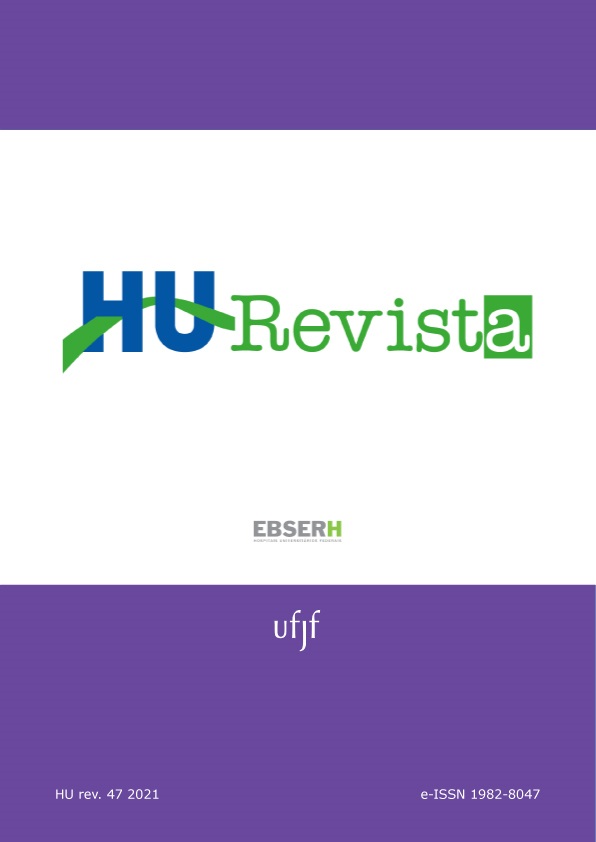Evaluation of the knowledge and practices of those responsible for disinfecting pacifiers
DOI:
https://doi.org/10.34019/1982-8047.2021.v47.32572Keywords:
Pacifiers, Decontamination, Health Education, Child HealthAbstract
Introduction: The habit of sucking a pacifier is common in children, as this object is a vehicle for contamination and transmission of disease-causing microorganisms, thus requiring correct disinfection. Objective: To evaluate the pacifier disinfection practices carried out by the guardians of children using pacifiers or that have already used it. Material and Methods: After ethical approval, a semi-structured questionnaire (12 questions) was applied to parents and grandparents of children who maintained the habit of pacifiers or who has interrupted it for a maximum of two years. The questions dealt with pacifier disinfection habits, access to disinfection instruction and health professionals, including dentists. The association between categorical variables was established using the Chi-square test and continuous variables using Pearson's correlation. The level of significance adopted was 5%. Results: 104 questionnaires were considered for the sample. The average age of the respondents was 32 years, the majority of whom were women (91.3%). The average age of children who used a pacifier was 26 months. Although boiling water is the most reported method of disinfecting pacifiers (35.6%), 15.4% of respondents reported using only running water. In addition, only 20.2% of respondents received any instruction from health professionals on disinfection, and only 29.8% reported having already taken the child to the dentist. The association between the frequency of pacifier disinfection and the frequency of going to the dentist was statistically significant. Conclusion: The knowledge by parents and family members about the disinfection of pacifiers was not adequate in this study. This fact may be related to the lack of access to information, through health professionals.
Downloads
References
Vozza I, Capasso F, Marrese E, Polimeni A, Ottolenghi L. Infant and child oral health risk status correlated to behavioral habits of parents or caregivers: a survey in central Italy. J Int Soc Prev Community Dent. 2017; 7(2):95-9.
Nelson-Filho P, da Silva LA, da Silva RA, da Silva LL, Ferreira PD, Ito IY. Efficacy of microwaves and chlorhexidine on the disinfection of pacifiers and toothbrushes: an in vitro study. Pediatr Dent. 2011; 33(10):10-3.
Souza VGC, Lopes DF, Machado FC, Fabri RL, Apolônio ACM. The novel coronavirus: an alert for pacifiers’ disinfection. Pesqui Bras Odontopediatria Clín Integr. 2020; 20:e0071.
Van Doremalen N, Bushmaker T, Morris DH, Holbrook MG, Gamble A, Williamson BN et al. Aerosol and surface stability of SARS-CoV-2 as compared with SARS-CoV-1. The New England Journal of Medicine. 2020; 382(16):1564-7.
National Health Commission of the People’s Republic of China, 2020. 6th Edition of COVID-19 Treatment Regimen (Trial Implementation) (in Chinese). [Acessado em 7 mar 2020]. Disponível em: http://www.nhc.gov.cn/yzygj/s7653p/202002/8334a8326dd94d329df351d7da8aefc2.shtml.
Wang WK, Chen SY, Liu IJ, Chen YC, Yang CF, Chen PJ, et al. Detection of SARS-associated coronavirus in throat wash and saliva in early diagnosis. Emerg Infect Dis. 2004; 10(7):1213-9.
Sri Santosh T, Parmar R, Anand H, Srikanth K, Saritha M. A review of salivary diagnostics and its potential implication in detection of Covid-19. Cureus. 2020; 12(4):e7708.
Lopes DF, Fernandes RT, Medeiros YL, Apolônio ACM. Disinfection of pacifier focusing on Candida albicans. Clin Pediatr. 2019; 58(14):1540-3.
Comina E, Marion K, Renaud FN, Dore J, Bergeron E, Freney J. Pacifiers: a microbial reservoir. Nurs Health Sci. 2006; 8(4):216-23.
Wei M, Yuan J, Liu Y, Fu T, Yu X, Zhang ZJ. Novel coronavirus infection in hospitalized infants under 1 year of age in China. JAMA. 2020; 2020.
Xu R, Cui B, Duan X, Zhang P, Zhou X, Yuan Q. Saliva: potential diagnostic value and transmission of 2019-nCoV. International Journal of Oral Science. 2020; 12:11.
Mattos-Graner RO, de Moraes AB, Rontani RM, Birman EG. Relation of oral yeast infection in Brazilian infants and use of a pacifier. ASDC J Dent Child. 2001; 68(1):33-6.
Informações de Saúde. [Acessado em 6 jan 2020]. Disponível em: https://datasus.saude.gov.br/informacoes-de-saude-tabnet/.
Instituto Brasileiro de Geografia e Estatística (BR). Conheça o Brasil: população: cor ou raça. 2020. [Acessado em 6 jan 2020]. Disponível em: https://educa.ibge.gov.br/jovens/conheca-o-brasil/populacao/18319-cor-ou-raca.html.
Molepo J, Molaudzi M. Contamination and disinfection of silicone pacifiers: an in vitro study. S Afr Dent. 2015; 70(8):351-3.
Lewis MAO, Williams, DW. Diagnosis and management of oral candidosis. Br Dent J. 2017; 223(9):675-681.
Silveira LC, Charone S, Maia LC, Soares RMA, Portela MB. Biofilm formation by Candida species on silicone surfaces and latex pacifier nipples: an in vitro study. J Clin Pediatr Dent. 2009; 33(3):235-40.
Chin AWH, Chu JTS, Perera MRA, Hui KPY, Yen HL, Chan MCH et al. Stability of SARS-CoV-2 in different environmental conditions. Lancet Microbe. 2020; 1:e10.
Rabenau HF, Kampf G, Cinatl J, Doerr HW. Efficacy of various disinfectants against SARS coronavirus. J Hosp Infect. 2005; 61:107-11.
Anopa Y, Conway DI. Exploring the cost-effectiveness of child dental caries prevention programmes. Are we comparing apples and oranges? Evid Based Dent. 2020; 21(1):5-7
Wang Y, Zhou CC, Shu R, Zou J. Oral health management of children during the epidemic period of coronavirus disease 2019. Sichuan Da Xue Xue Bao Yi Xue Ban. 2020; 51(2):151-4.
Barreto ML. Desigualdades em saúde: uma perspectiva global. Cien Saude Colet. 2017; 22(7):2097-108.
Downloads
Published
How to Cite
Issue
Section
License
Copyright (c) 2021 Danielle Fernandes Lopes, Vívian Gonçalves Carvalho Souza, Rodrigo Luiz Fabri, Isabel Cristina Gonçalves Leite, Ana Carolina Morais Apolônio

This work is licensed under a Creative Commons Attribution 4.0 International License.
Cessão de Primeira Publicação à HU Revista
Os autores mantém todos os direitos autorais sobre a publicação, sem restrições, e concedem à HU Revista o direito de primeira publicação, com o trabalho licenciado sob a Licença Creative Commons Attribution que permite o compartilhamento irrestrito do trabalho, com reconhecimento da autoria e crédito pela citação de publicação inicial nesta revista, referenciando inclusive seu DOI.









